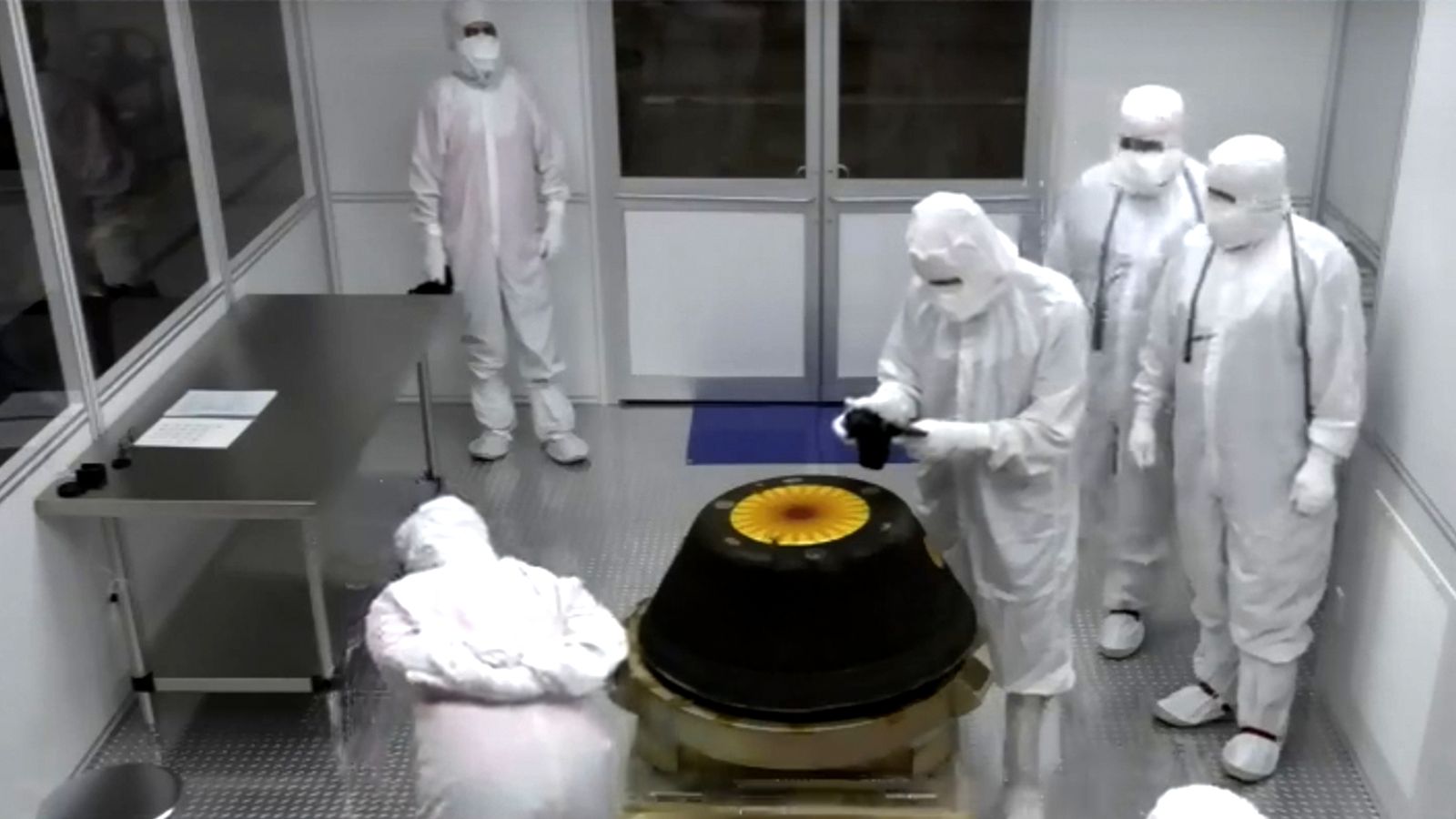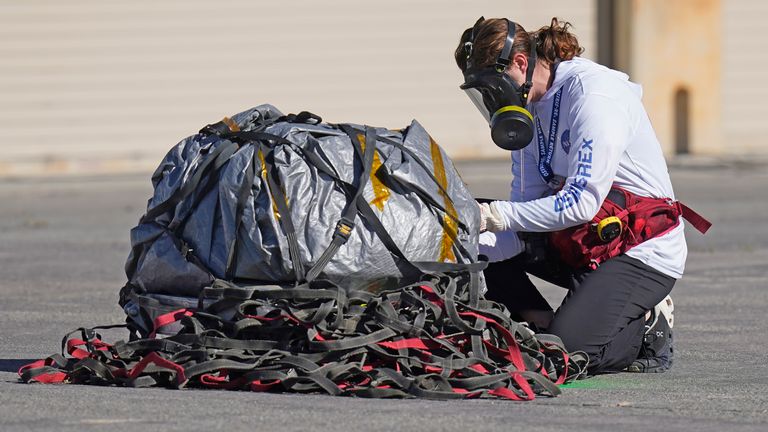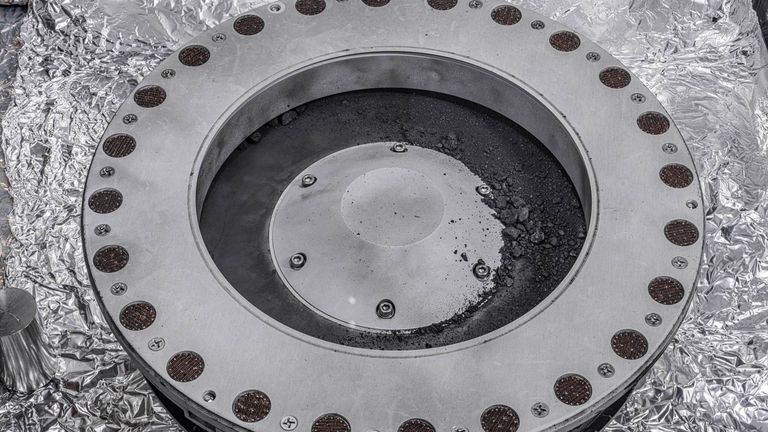NASA has revealed its “incredible” findings from a sample that was scooped up from the surface of an asteroid and delivered to Earth by spacecraft.
The sample, ancient black dust and chunks, was collected from the carbon-rich asteroid named Bennu, almost 60 million miles away.
It is the largest ever returned to Earth.
NASA‘s Osiris-Rex spacecraft collected the samples three years ago and then dropped them off sealed in a capsule during a flyby of Earth last month.
Scientists hope it can shed light on the origin of the solar system and of life on Earth.
An Osiris-Rex sample analyst, Daniel Glavin, said during a news conference to reveal the material that the sample was “loaded with organics”.
“This is just incredible material,” he said.
“This stuff is an astrobiologist’s dream, I just can’t wait to get at it.”
The scientists have been investigating whether asteroids like Bennu seeded the Earth with pre-biotic chemicals.
Mr Glavin said: “We’re going to learn so much about the origin of the solar system, the evolution and potentially how even life started here on Earth.”
Dante Lauretta, Osiris-Rex principal investigator, said the different sized stones contained in the sample would provide invaluable information for scientists.
‘Something from space we have never seen in our laboratories’
“Something like that would not make it to the surface of the Earth as a meteorite,” he said.
“So to have something from space that we have never seen in our laboratories, there is nothing more exciting.”
Bennu is considered the most dangerous asteroid in the Solar System – although NASA has estimated its chances of actually hitting Earth in 2182 are remote, at just one in 2,700, or 0.037%.
Lori Glaze, director of the agency’s planetary science division, explained how the latest sample could help protect our planet from a catastrophic impact with a space object.
She said the mission allowed NASA to measure a small force created by the sun’s heat and an asteroid’s rotation – explaining this force was “really important for helping us to predict when a particular asteroid might be dangerous”.
“What we really want to know is if an asteroid is going to cross over Earth’s orbit at the same time that we are in that place, and we want to not be in that place when an asteroid comes by,” she said.
Administrator Bill Nelson – explained the discovery was unprecedented.
“At nearly 5% carbon by weight, carbon being the central element of life, far exceeding our goal of 60g, this is the biggest carbon-rich asteroid sample ever returned to earth,” he said.
Carbon and water molecules are “exactly the kind of material that we wanted to find”, Mr Nelson added.
“They are going to help us determine the origin of elements that could have led to life.”
Sky News Science Correspondent Thomas Moore explains what it all means.
So much material has been brought back from asteroid Bennu that it has spilled out of the collection cannister.
NASA scientists still haven’t got inside – they’ve been carefully sweeping together their “bonus sample” to make sure it’s not wasted.
It’s slowed them down, so they’ve only had time to do a basic analysis of the material in the fortnight or so since the capsule parachuted down to Utah’s western desert last month.
Results so far show that it is rich in carbon, an essential element for the organic molecules that are the building blocks of life.
And stunning high magnification images taken with an electron microscope reveal fibrous clay particles that contain water.
That adds to evidence that asteroids bombarding planet Earth billions of years ago brought water that formed the oceans, and also the seeds of life.
But this is just the start.
They now need to work out exactly what chemicals are in the sample.
Analysis of material brought back from another asteroid called Ryugu by a Japanese spacecraft revealed dozens of organic compounds, including amino acids that form proteins.
There was only a tiny amount of material brought back from Ryugu and scientists haven’t yet been able to detect any of the chemical ingredients for making RNA and DNA, the genetic codes of life on Earth.
But there is much more material brought back from Bennu.
Just over a quarter of the material will be analysed over the next two years by scientists at laboratories around the world, including a team at the Natural History Museum in London.
The rest will be preserved for future analysis, as NASA says, by scientists who haven’t been born yet using techniques that can only be imagined.
That might tell us more about our origins. But perhaps also give clues to how our planet formed.
Bennu is a window into the early days of the solar system, 4.5 billion years ago. It’s likely to have changed very little since it was formed from loose rubble orbiting between Mars and Jupiter.
The planets would have been formed from the same material. But Bennu’s material is pristine, unchanged by the intense heat and pressure involved in making a planet.
You can sense the excitement of the scientists. They’ve had so many questions about our place in the Universe.
And with the Bennu sample they might start getting some answers.
This story originally appeared on Skynews



